Ferry
-
- To the North, South And A Little Island Sheltered Maritime Reporter, Jan 2003 #27
To those not familiar with the New York metropolitan area — the eastern end of Long Island is demographically multi-faceted. Traveling east on the Long Island Expressway, (the Island' main thoroughfare).
the 118-mile long island, splits into two "forks," the North and the South. With the hamlets of Greenport and Orient Point situated on the easternmost points of the island on the north, the South Fork boasts the tony Hampton villages and the historical village of Montauk Point — literally the end of the earth before reaching the whitecaps of the Atlantic Ocean. While the two forks may differ in reputation and history — they have one similarity — a small island "sheltered" in between. Known as Shelter Island, this piece of land, which is as historical as it is controversial — is serviced by two ferry companies — North Ferry and South Ferry.
By Regina P. Ciardiello, managing editor "Go east," was the mandate from my editor to find a story for the Passenger Vessel Annual, so I traveled as far east on Long Island as possible without getting my feet wet.
MR/EN stopped in to see Capt. Cliff Clark and Bill Clark, the brothers who operate the 200-year old South Ferry. As the fifth-generation of the family, the brothers manage the four-vessel fleet from their headquarters on the Southern tip of the Island — linking passengers and vehicles to the village of North Haven located in the South Fork of Long Island — just outside a small town known as Sag Harbor.
On the North Fork, the North Ferry terminal is located in the hamlet of Greenport, bringing vehicles and passengers to the northern end of the island, which can then link up to the south by driving about 4.5 miles via Route 114. to the South Ferry terminal.
While the company's traditions may be "old school," South Ferry's fleet exemplifies the new breed of ferry transportation. With myriad of refits and refurbs to its two older vessels — North Haven and South Ferry II — the company has added two new technologically advanced ferries — Southern Cross and Sunrise — to its fleet. With the addition of Southern Cross in 1998 and Sunrise this past summer, the vessels, could very well be "updated" versions of the Southside and Sunrise — two 65-ft.
(19.8-m), yellow pine wooden boats that were constructed by Cliff and Bill's grandfather, C.Y. Clark, in 1925 and 1926, respectively, and the last wooden boats to built by the Clark family. According to historical reports obtained from South Ferry, these original vessels remained in service to Shelter Island until 1941 when North Ferry built its first steel vessel. Islander.
History in the Making While both the North and South Ferry companies have historical roots planted on Shelter Island for generations. (North Ferry for more than 100 years, South Ferry since 1793), South Ferry designates itself as the oldest family-owned ferry company in the U.S. While some may balk at this statement, Bill Clark. South Ferry's vice president, touts "blood is thicker than water," and invites anyone who disagrees with the statement to come forward and state their case. According to the South Ferry Crew Book, the company was established sometime during the late 1700's more than likely at the close of the Revolutionary War, when Samuel G.
Clark came across the Long Island Sound from Connecticut into Shelter Island, where he purchased the property where a local marina now stands, and opened a ferry service to the Island.
Some years later, he decided to settle on the south side of the Island, (where the newest generation of the Clark family still resides), and purchased an area of land to establish his farming efforts. It was on the south side, that Samuel decided he would remain, and once again, set up a ferry service (this time from the south side), via a rowboat that would aid boatless travelers to navigate between his land and what was then known as Hog Neck (now North Haven).
Moving ahead to the 19th Century. South Ferry progressed for its time, with travel to North Haven stepping up. so did ferry trips to and from Shelter Island, with the sons of the company's original owner. Samuel and David running the business.
With Samuel moving beyond South Ferry in the late 1800's, David assumed the helm of South Ferry, and managed to expand the "fleet" in 1888 with the purchase of Elloine, a 32-ft. (9.7-m) boat, which towed a scow for cargo and carriages with horses tethered alongside. Following the death of David, due to a severe case of pneumonia, his son, Clifford Y. Clark, began the third-generation of South Ferry by building an even larger scow at the turn of the Century, which accommodated a carriage with hitched horse, known as Fannie.
Measuring 20 x 10 ft. (6 x 3 m), the boat, which served with Elloine, made trips back and forth to carry passengers and supplies.
At the turn of the century designated South Ferry became official when it was incorporated under the laws of the State of New York in 1906, with all positions of officers and directors held by family members. Capt. C.Y. Clark took South Ferry, (and survived) past some of the most historical events of our time — WWI, the Great Depression and WWII. It was also at this time (the 1920's), that the State of New York brainstormed an idea to build a bridge linking North Haven to Hay Beach at Orient Point — due East of Greenport where the North Ferry currently operates from. Even though plans had been drawn up and serious discussions had.
(South Ferry even held a role by renting out Elloine at $50 per day to take soundings for the New York State surveyors), the idea never came to fruition and was eventually dropped.
With no imminent plans for a structural link between the island, the ferries were the only means of transport to get not only passengers on and off the Island, but much-needed supplies as well. Seeing the rise in truck traffic during the 1940's, the Clark family designed and built the first known independent stanchions with no overhead obstructions, the concept, which had never before been introduced on Long Island, has gone on to become a popular method for ferry boats operating today.
Following WWII, C.Y. Clark remained at the head of the family operation, while extending the operations to his two sons, Donald and William (Capt.
Cliff and Bill's father), who would be known as the fourth generation of Clarks to run South Ferry. According to Cliff Clark, who as the fifth generation of the family, serves as the company's president, "South Ferry is a work in progress, our ancestors had a vision and a passion — they saw what others didn't," he said.
William, who happened to be a "genius" when it came to General Motors 671 diesel engines, was (like his HRISE ancestors), born on Shelter Island, but didn't see it as this sleepy, little community, but as one that could thrive with the operation of a structured, innovative ferry business. While Donald concentrated his efforts on the operational side, William was hands-on, advancing the company technically, while focusing on the utmost in customer service. The new "Patriarch" of South Ferry relieved the company of all outside maintenance costs by working with machinist Otto Hulse in his Greenport machine shop. It was through Hulse, and self-taught mechanical knowledge, that William would go on to hold the title of Eastern Long Island's "expert" on General Motors 671 engines. This was especially helpful when economic times were tough, especially before the cultural boom of the Hamptons and Shelter Island. Rather than balk on service. William would maintain the ferries, paint them, and fix the engines himself — rather than disappoint his customers by halting service.
And this philosophy has become a mainstay. According to Bill Clark, vice president of South Ferry (and William's son), "there has never been a day where the ferry has not run." Even if the usual three-minute trip between the Island and North Haven, took three hours due to ice and/or snow, the ferry would still make its way across.
With the death of C.Y. Clark (William's father) in 1961, William assumed full responsibility of the company, furthering his vision and passion for South Ferry. He worked on additional improvements, such as new painting and coating methods - mainly zinc, which replaced what, was (at that time) the dangerous and ineffective red lead. According to Cliff Clark, his father's motto was. "Blast it. zinc it, and paint it." William found that zincing made a huge difference in the maintenance of the ferry fleet as it prevented the steel from rusting. In addition to his focus on the maintenance of the fleet. William Clark, gave just as much, if not more attention.
to those who were (and still are today), the livelihood of the South Ferry operation — the customers. "Dad had a passion for giving good service and taking care of his customers," Cliff Clark said. "While he embraced new ways for operation, he was also a deeply spiritual person, with a strong faith." As a devout Christian, William believed that the core of the company's charter was "the desire to try new things based on Christian principles," furthering his spirituality and strong faith, which carried over into his business philosophy.
While William was a passionate, spiritual man, he was a devout businessman as well, sometimes sacrificing his own needs for those of his customers. Cliff remembers one specific time when his father, who had his car in line for the ferry on a busy summer day during a holiday weekend, and upon discovering that there was only a spot for one more vehicle, backed up his car and turned around, so that the line of cars behind him could load up the ferry.
Involved to the End Even up until his last days, William still remained an active part of South Ferry — despite his deteriorating health. A few days before their father passed away, William and Cliff remember the day he was brought home via ambulance, making sure that his stretcher was raised to a point that he could see his ferry's namesake — Captain Bill Clark — pulling into the terminal as he arrived home. As the ferry went by, William didn't complement the gesture, he merely stated, "Keep her that way." Referring to the vessel's current condition. He died three days later on April 24, 1999 at the age of 86.
Today, both Cliff and Bill, oversee the daily operations of South Ferry, while continuing to instill their father's foundation for providing the utmost in customer service and innovation. Mainly with the addition of their newest vessel, M/V Sunrise, which was delivered from Warren. R.I.-based Blount-Barker Shipbuilding this past summer. The vessel is the beginning of the new generation at South Ferry. With its two Detroit Diesel engines, two Twin Disc gears and Rolls Royce propellers, the 101-ft. (30.7-m) double-ended ferry was built by Blount-Barker for $1.4 million. According to Bill Clark, South Ferry's vice president. Sunrise, which replaces the former Captain Ed Cartwright, has (instead of the traditional reverse gear bolted up to the engine) a stand alone reverse gear, which makes it easier to replace the vessel's Vulkan couplings.
"If there's any (coupling) failure onboard on a busy day, this will enable us to change the coupling in just a few hours. Bill mentioned other innovations such as fixed engine room Inergen Ansul fire suppression system, which utilizes nonlethal gas. "The Inergen system puts out a fire in the engine room by reducing the oxygen level in the engine room," Bill said. "But leaves enough oxygen for breathing." The ferry also employs high efficiency deck floodlights by Phoenix, two independent pilothouse system control stations with emergency back-up controls and redundant navigation lights, which Bill explained have a back-up fixture. "In case a bulb burns out, the ferry captain would hear and see both and audible and visual alarm that would release a back-up light until the bulb could be replaced.
"We want to provide good service here," Bill said, "The need for new equipment is driven by demand and the equipment matches the demand." Will South Ferry expand its fleet in the near future?
While Bill did not elaborate on the subject, he did not completely rule it out either. "The trend on the East End of Long Island is growth," he said.
"Sometime in the near future we will increase capacity, either by putting a 30-ft. (9.1-m) midbody into one of our existing boats or constructing another one." He added: "We (South Ferry) were very pleased with Blount-Barker, and if it gets to the point where we're ready to build again, we'd love to build another boat with them." While Bill admits that 2002 was not as good a year for South Ferry as 2001, that does not mean that the ferry industry is in jeopardy. "There's more of a demand for ferry service," he said. "The trend is steady and it will evolve into the future. While there are no concrete plans right now. I am certain that the time will come when we will need a new ferry."
-
- Ferry Fixation: The Good, the Bad and the Ugly Marine News, Jan 2015 #24
footprint. The future for ferries seems to be on fire; both in good ways and bad. The good is always a good place to start. And, that’s because it is ferry fabrication time. The most notable ferry routes in America are jumping into the construction queue for new vessels and soon the next generation of
-
- Ferries V2.0. Post COVID Opportunities Marine News, Sep 2021 #12
Since the 1980s there has been a remarkable revival of ferry services in many U.S. waterfront cities, but COVID-19 has wreaked havoc on the most profitable component of these services: the commuter runs. With post-COVID work-at-home arrangements and part-week in-office work, these ferry services have
-
- Ferry Tales: Having a Ferry Good Time Marine News, Jan 2017 #16
Despite of some of the lowest fuel prices experienced in the last eight years, demand for ferry construction is at a seemingly all time high. The focus on building new ferries kicked off in early 2013 and the sustained interest is the continued result of an unleashing of pent up demand. Fleets have been
-
- Peterson To Build Ferry For Washington Island Ferry Line Maritime Reporter, Dec 15, 1978 #41
Capt. Ami Richter, president of the Washington Island Ferry Line, Inc., and Joe Gagnon, vice president and general manager of Peterson Builders, Inc., shipbuilders of Sturgeon Bay, Wis., recently signed a contract for construction of a new 90-foot by 36-foot ferry for service across Death's Door
-
- CRUISE + FERRY '89 Maritime Reporter, May 1989 #12
May 24-25, London, England Cruise + Ferry 89, the international conference and exhibition on the passenger cruise and ferry industry, will be held at the Kensington Exhibition Center in London, England, on May 24-25, 1989. With unprecedented growth forecast for the cruise industry as it approaches
-
- Citywide Ferry by Hornblower Takes Center Stage Maritime Reporter, Jan 2017 #30
. Last month we visited with Cameron Clark, Corporate Vice President, Development and Special Projects, Hornblower, the project manager for the new Citywide Ferry by Hornblower fleet, who discussed the challenges and opportunities ahead. Hornblower has, in the span of 36 years, become the force in the U.S
-
- Rough Waters for Washington State Ferries Marine News, Jan 2016 #32
Improved funding and management changes have the nation’s largest ferry system on a course to better times. Challenges remain, but WSF tackles each one in turn. Unlike the citizens of British Columbia, which pays a German shipyard to build its ferries, Washington state residents resolutely invest at home.
-
- Ferry Safety in the Developing World Marine News, Jan 2015 #28
A convergence of forces makes for market opportunities for new safe ferry systems in the developing world. Need, policy, and funding are poised to provide a moment of opportunity. The expanding global economy has resulted in economic and population growth in developing world cities, resulting in horrendous
-
- Ferries: An Economic Driving Force Marine News, Jan 2016 #20
when schedules, fares or routes are changed. But while this mode of transportation is as vital for some communities as other methods of transportation, the ferry sector does not, generally, receive the same amount of visibility. And that is an issue. Planes, trains and automobiles. That’s not just the
-
- CRUISE + FERRY 1991 CONFERENCE & EXHIBITION London, May 29-31 Maritime Reporter, May 1991 #52
Regarded as one of the world's largest passenger ship shows, Cruise + Ferry has been scheduled for May 29 to 31, 1991 in London's Olympia 2 Conference and Exhibition Center. The biennial event, with its large international exhibition, is a premier meeting place for all those engaged in passenger
-
- Insights: Johan Roos, Interferry's Executive Director of EU and IMO Affairs Marine News, Jan 2015 #12
Johan Roos is Interferry’s executive director of European Union and IMO affairs based in Brussels, Belgium. He took up the newly created regulatory affairs post in September 2011 after previously serving as director of sustainability with Sweden’s Stena Rederi AB. He holds a masters degree in environmental
-
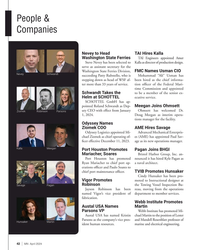 )
April 2024 - Marine News page: 42
)
April 2024 - Marine News page: 42People & Companies Nevey to Head TAI Hires Kalla Washington State Ferries TAI Engineers appointed Amer Steve Nevey has been selected to Kalla as director of production design. serve as assistant secretary for the FMC Names Usman CIO Washington State Ferries Division, Nevey Schwandt succeeding Patty
-
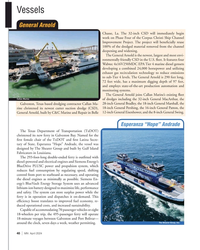 )
April 2024 - Marine News page: 40
)
April 2024 - Marine News page: 4012-inch General Eisenhower, and the 8-inch General Swing. Esperanza “Hope” Andrade The Texas Department of Transportation (TxDOT) christened its new ferry in Galveston Bay. Named for the ? rst female chair of the TxDOT and ? rst Latina Secre- tary of State, Esperanza “Hope” Andrade, the vessel was
-
 )
April 2024 - Marine News page: 35
)
April 2024 - Marine News page: 35all provided ? nancial support and other resources. “This tug becomes somewhat commercially viable be- cause of the grant process,” Manzi said. “Unlike a ferry service that’s paid for by tax dollars, we have to collect fares and tariffs from the shipowners. Right now, the technol- ogy is out over market
-
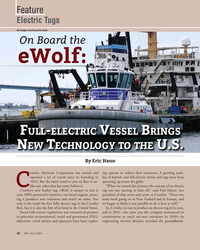 )
April 2024 - Marine News page: 32
)
April 2024 - Marine News page: 32Feature Electric Tugs All images courtesy Eric Haun On Board the eWolf: F - V B ULL ELECTRIC ESSEL RINGS EW ECHNOLOGY TO THE N T U.S. By Eric Haun rowley Maritime Corporation has owned and ing options to reduce their emissions. A growing num- operated a lot of vessels since its founding in ber
-
 )
February 2024 - Maritime Reporter and Engineering News page: 22
)
February 2024 - Maritime Reporter and Engineering News page: 22R&D MATT HART Matt Hart, Manager & Platform Leader, Marine & Stationary Power Systems, Wabtec, offers insights on how the megatrends of decarbonization, energy transition and autonomy all inspire Image courtesy Wabtec and impact the marine power solutions from Wabtec. By Greg Trauthwein Matt, to start
-
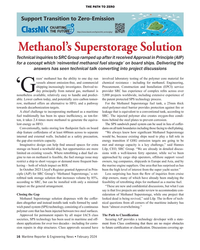 )
February 2024 - Maritime Reporter and Engineering News page: 16
)
February 2024 - Maritime Reporter and Engineering News page: 16more Lilp, CEO, SRC Group. “We are already in detailed discus- limited on existing vessels. Where retro? tting a dual fuel en- sions with a well-known ferry operator, while we’ve been gine to run on methanol is feasible, the fuel storage issue may approached by cargo ship operators, offshore support vessel
-
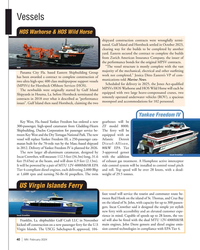 )
February 2024 - Marine News page: 40
)
February 2024 - Marine News page: 40gearboxes will be 300-passenger, high-speed catamaran from Gladding-Hearn ZF model 8000. Shipbuilding, Duclos Corporation for passenger service be- The ferry will be tween Key West and the Dry Tortugas National Park. The new equipped with an vessel will replace Yankee Freedom III, a 250-passenger cata-
-
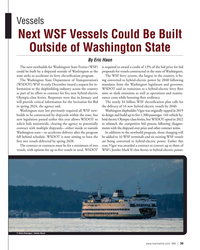 )
February 2024 - Marine News page: 39
)
February 2024 - Marine News page: 39bid could be built by a shipyard outside of Washington as the proposals for vessels constructed in the state of Washington. state seeks to accelerate its ferry electri? cation program. The WSF ferry system, the largest in the country, is be- The Washington State Department of Transportation’s ing converted
-
 )
February 2024 - Marine News page: 36
)
February 2024 - Marine News page: 36, important play for us,” Burry said, pointing to strong po- and currently the market leader in that area, we have effected a tential in the cruise and ferry industries. lot of regulatory change,” Burry said. “We were the ones who The ? nal delivery for BC Ferries includes a dozen 22- started the process
-
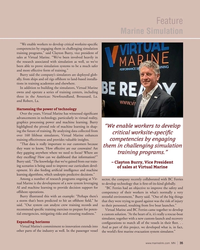 )
February 2024 - Marine News page: 35
)
February 2024 - Marine News page: 35Feature Marine Simulation “We enable workers to develop critical worksite-speci? c competencies by engaging them in challenging simulation training programs,” said Clayton Burry, vice president of sales at Virtual Marine. “We’ve been involved heavily in the research associated with simulation as well
-
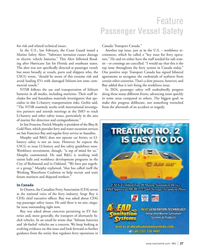 )
February 2024 - Marine News page: 27
)
February 2024 - Marine News page: 27Another top issue, just as in the U.S. – workforce re- Marine Safety Alert: “Saltwater intrusion causes damage cruitment, which he called a “key issue for ferry opera- to electric vehicle batteries.” This Alert followed ? ood- tors.” He said we either have the staff needed for safe tran- ing after Hurricane
-
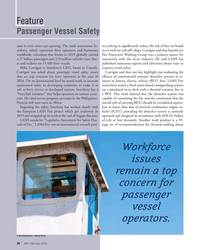 )
February 2024 - Marine News page: 26
)
February 2024 - Marine News page: 26Feature Passenger Vessel Safety ume is even more eye-opening. The trade association In- ect seeking to signi? cantly reduce the risk of ? res on board terferry, which represents ferry operators and businesses ro-ro (roll on–roll off) ships. Corrigan said that Interferry’s worldwide, calculates that ferries
-
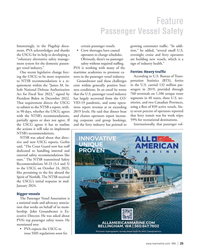 )
February 2024 - Marine News page: 25
)
February 2024 - Marine News page: 25have caused tion,” he added, “several small U.S. the USCG for its help in developing a operators to change schedules. overnight cruise and ferry operators “voluntary alternative safety manage- Obviously, there’s no passenger are building new vessels, which is a ment system for the domestic
-
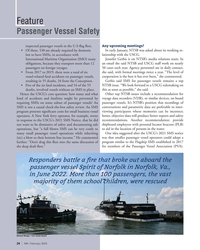 )
February 2024 - Marine News page: 24
)
February 2024 - Marine News page: 24to inter- program presents signi? cant costs for small business vessel viewing participants whose memories can be incorrect; operators. A New York ferry operator, for example, wrote better, objective data will produce better reports and safety in response to the USCG’s 2021 SMS Notice, that he did
-
 )
February 2024 - Marine News page: 23
)
February 2024 - Marine News page: 23crossing SMS Advance Notice of Proposed Rulemaking for passen- ger vessels in January 2021. But “progress has been stalled,” from the Mukilteo, Wash. ferry terminal to Whidbey Is- she wrote, and that Advance Notice hasn’t advanced. land or a family on a ? shing vessel in Miami. Importantly, though, for
-
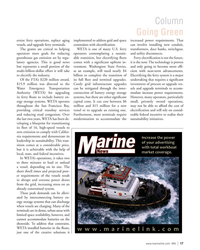 )
February 2024 - Marine News page: 17
)
February 2024 - Marine News page: 17Column Going Green ernize ferry operations, replace aging implemented to address grid and space increased power requirements. That vessels, and upgrade ferry terminals. constraints with electri? cation. can involve installing new conduit, The grants are critical to helping WETA is one of many U.S.
-
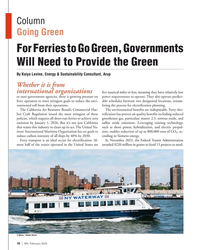 )
February 2024 - Marine News page: 16
)
February 2024 - Marine News page: 16, meaning they have relatively low or state government agencies, there is growing pressure on power requirements to operate. They also operate predict- ferry operators to meet stringent goals to reduce the envi- able schedules between two designated locations, stream- ronmental toll from their operations
-
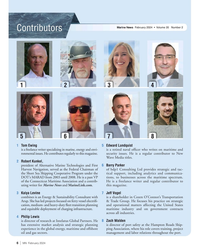 )
February 2024 - Marine News page: 6
)
February 2024 - Marine News page: 6Vogel combines is an Energy & Sustainability Consultant with is a shareholder in Cozen O’Connor’s Transportation Arup. She has led projects focused on ferry vessel electri? - & Trade Group. He focuses his practice on strategic cation, medium- and heavy-duty ? eet transition planning and operational matters
-
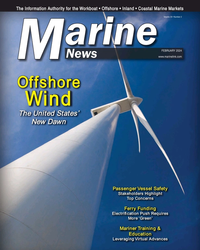 )
February 2024 - Marine News page: Cover
)
February 2024 - Marine News page: Cover2 arine FEBRUARY 2024 www.marinelink.com News M Offshore Wind The United States’ New Dawn Passenger Vessel Safety Stakeholders Highlight Top Concerns Ferry Funding Electrifcation Push Requires More ‘Green’ Mariner Training & Education Leveraging Virtual Advances
-
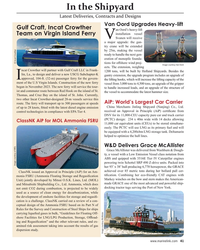 )
January 2024 - Maritime Reporter and Engineering News page: 41
)
January 2024 - Maritime Reporter and Engineering News page: 41, Contracts and Designs Van Oord Upgrades Heavy-lift Gulf Craft, Incat Crowther an Oord’s heavy-lift installation vessel Team on Virgin Island Ferry VSvanen will receive a major upgrade: the gan- try crane will be extended by 25m, making the vessel ready to handle the next gen- eration of monopile
-
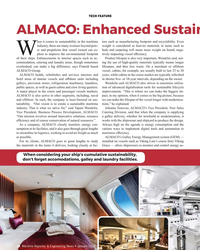 )
January 2024 - Maritime Reporter and Engineering News page: 38
)
January 2024 - Maritime Reporter and Engineering News page: 38. ALMACO’s Galley Energy Management system (GEM) — For its clients, ALMACO goes to great lengths to study installed on vessels such as Viking Line’s cruise ferry Viking the materials in the items it delivers, looking closely at fac- Grace — allow shipowners to monitor and control energy us- When considering
-
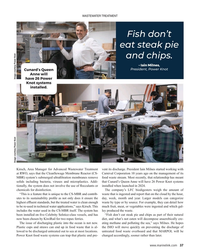 )
January 2024 - Maritime Reporter and Engineering News page: 37
)
January 2024 - Maritime Reporter and Engineering News page: 37WASTEWATER TREATMENT Fish don’t eat steak pie and chips. – Iain Milnes, President, Power Knot Cunard’s Queen Anne will have 26 Power Knot systems installed. Image courtesy Power Knot Image courtesy Power Knot Kirsch, Area Manager for Advanced Wastewater Treatment vent its discharge. President
-
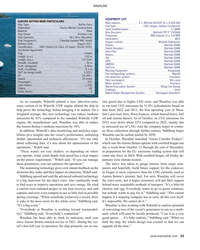 )
January 2024 - Maritime Reporter and Engineering News page: 33
)
January 2024 - Maritime Reporter and Engineering News page: 33WASALINE EQUIPMENT LIST AURORA BOTNIA MAIN PARTICULARS Main engines: 4 × Wärtsilä 8V31DF (4 × 4,400 kW) Ship Type: RoPax Ferry Fuel type: LNG, biogas, battery (Leclanche) Shipbuilder: Rauma Marine Constructions Total installed power: 17,6MW Material: Steel Bow thrusters: Wärtsilä FPP
-
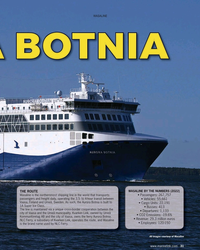 )
January 2024 - Maritime Reporter and Engineering News page: 31
)
January 2024 - Maritime Reporter and Engineering News page: 311,133 city of Vaasa and the Umeå municipality. Kvarken Link, owned by Umeå • CO2 Emissions: -19.6% Kommunföretag AB and the city of Vaasa, owns the ferry Aurora Botnia. • Revenue: 29.3 million euros NLC Ferry, a subsidiary of Kvarken Link, operates the route, and Wasaline • Employees: 120-150 is the
